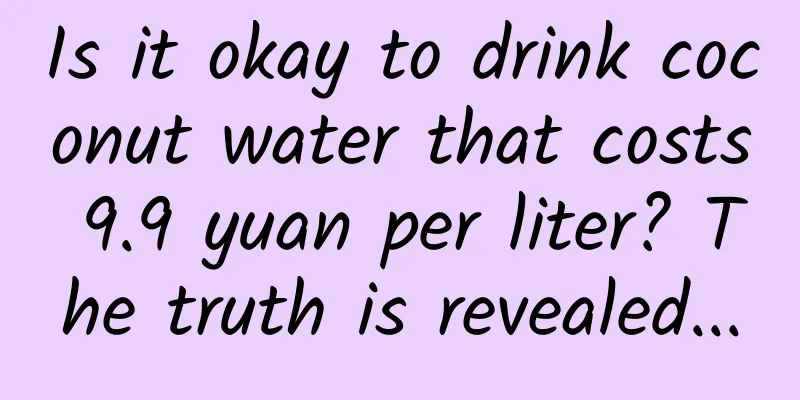Is it okay to drink coconut water that costs 9.9 yuan per liter? The truth is revealed...

|
As the weather gets hotter, has your blood been rekindled with a desire for coconut water? It is refreshing, delicious and slightly sweet. It is best to have a bottle when you are dizzy from the sun. The natural taste also makes you feel "very healthy". But the increasingly cheaper coconut water has caused many people to worry: a fresh coconut costs more than ten yuan, and it takes about three coconuts to make a liter of coconut water. Now there are a lot of coconut waters on the market that cost 9.9 yuan a liter. Can we drink them safely? Let’s start with natural coconut water. Copyright images in the gallery. Reprinting and using them may lead to copyright disputes. Coconut water Natural electrolyte water Coconut ( Cocos nucifera L. ) is a tree of the genus Cocos in the palm family. It is a very important oil crop and mainly grows in tropical areas. For example, the main area for coconut cultivation in China is Hainan. China has a history of more than 2,000 years of coconut tree cultivation. The basic structure of a coconut. Image source: WordPress/Wikipedia What's in a coconut? Coconut is the fruit of the coconut tree. The outermost smooth green thin skin of coconut is its exocarp, the thick and hard wood-like layer inside is its mesocarp, and the innermost bony hard shell is its endocarp. The seed coat of coconut is very thin and close to the inner pericarp. Therefore, when we cut open a coconut, we cut open the pericarp and the seeds inside at the same time, directly exposing the endosperm in the seeds. The endosperm is the nutrient reservoir of the seed, which can provide the energy and nutrients needed for the growth of the plant embryo. The endosperm is also the main food we eat when we eat rice and corn. The endosperm of coconut has two forms. The outer layer is white solid endosperm, which is what we usually call coconut meat. The other layer is liquid endosperm, which is the transparent coconut water we usually drink. Coconut water is a natural plant water formed by coconuts storing nutrients in the form of liquid endosperm in the fruit. The coconut water in a mature coconut accounts for about 15% to 30% of its weight, and the average coconut water volume is about 300 ml. The color of coconut water is basically close to transparent, with water content of about 94%, and the rest is soluble sugar, minerals, and a small amount of fat and protein. Coconut water has very low calories, only 19 kcal/100 g, and has a lower sugar content than most fruits, only 3% to 5%. It is composed of fructose, glucose and sucrose, and is rich in mineral elements such as potassium, sodium and magnesium. Since coconut water has a light sweetness and natural coconut fragrance without additional sugar, and also contains nutrients such as potassium and sodium, it is very suitable as a fluid supplement after a lot of sweating. Many people regard coconut water as a fruit drink and compare it with fruit juice. However, the vitamin C content in coconut water is not very high, even lower than the most common apple. You should know that every 100g of apple contains 4mg of vitamin C, which is lower than cabbage. Therefore, the nutrition of coconut water is still not as good as fruit juice, it is more like a natural electrolyte water. Copyright images in the gallery. Reprinting and using them may lead to copyright disputes. 9.9 per liter of coconut water Why is it so cheap? In fact, coconut water produced by regular manufacturers can be purchased and drunk with confidence. So, why is coconut water so cheap? The main reasons are: 1 Raw material cost control Enterprises can use coconuts from different origins for production and sales , such as mixing coconuts from Indonesia, Vietnam and other places with a small amount of Thai perfumed coconuts. This can not only reduce costs, but also improve the taste by adding a small amount of high-quality coconuts. It should be noted that the cost of Thai perfumed coconut raw materials is about 20 yuan/liter, while the cost of Indonesian old coconuts is only 4 yuan/liter; it can also be reconstituted with imported concentrated juice. 2 Deep processing and utilization of coconut Large enterprises can also use the deep processing of coconuts to utilize all the resources of the coconut body to reduce costs. Ordinary people like us buy coconuts to suck coconut water, and then throw away the coconut meat and coconut shells, but enterprises can continue to use them, such as squeezing coconut meat to make coconut milk products and selling them, making handicrafts from coconut shells and so on, which is equivalent to some other benefits, and also sharing the costs of enterprises. 3 Product Features Coconut water has a relatively long shelf life and can be stored at room temperature, which makes it less expensive to transport and store. In addition, some brands have further reduced costs by optimizing packaging design. Therefore, for large companies, it is possible to sell bottled coconut water at 9.9 yuan per liter, and everyone can buy and drink it with confidence. Coconut flakes, coconut milk, coconut milk, coconut juice... What are they? 1. Coconut People who like to drink coconut milk tea and beverages often drink coconut, and many people think it is the flesh of coconut. In fact, coconut is a product made from fermented coconut water , also known as coconut fiber fruit, coconut nata or high-fiber coconut. The method of making coconut flakes is to let acetic acid bacteria ferment in coconut water . Using the sugars and other substances in it, acetic acid bacteria can produce a polysaccharide - bacterial cellulose. They accumulate on the surface of coconut water to form a thick layer of white substance. After being scooped out and further processed, it becomes the coconut flakes that many people love to eat. Coconuts are mainly composed of polysaccharides and cellulose. They do not contain the rich potassium, calcium, magnesium and other minerals contained in fruits, nor do they contain a variety of vitamins contained in fruits, such as vitamin C, carotenoids, etc., so don't treat coconuts as fruits. 2. Coconut milk/coconut milk/coconut juice… Coconut milk refers to a beverage product made from coconut pulp (juice) and (or) coconut pulp juice as the main raw materials, with other raw materials added and then prepared through blending, sterilization, filling and other processes. There are also coconut milk, coconut juice, thick coconut milk and so on on the market. In fact, they are all made from coconut meat. Although the names are different, the essence is the same. The name of "coconut milk/coconut milk" easily makes people think that drinking it is equivalent to drinking milk. In fact, coconut milk is not a dairy product, but a plant protein beverage , just like the soy milk, almond milk, and walnut milk that everyone drinks. It belongs to the concept of "plant milk" that has become popular in recent years. But they are essentially plant protein beverages, which are completely different from milk. References [1]. Lu Lilan, Liu Rui, Xiao Yong, Li Jing, Shen Xiaojun, Li Heshuai, Fan Haikuo. Research progress on coconut germplasm resources, cultivation and utilization[J]. Journal of Tropical Crops, 2021, 42(6): 1795-1803 [2].T/HNSKXH 004-2024 Coconut milk (milk) [3].T/HNSKXH 005-2024 Coconut water and its beverages [4].T/HNCA 001-2023 Coconut milk [5].QB/T 2300-2006 Plant protein beverage coconut juice and reconstituted coconut juice [6]. Li Tong, Zhang Caihong, Guo Honghua. Analysis of the mechanism of action and clinical application of coconut water in medical health care[J]. Trace Elements and Health Research, 2021, 38(03): 45-48. [7]. Liu Xiaoqin, Guo Zhiyong, Cui Xinyue, Bai Xinpeng. Research on the preparation and stability of artificial coconut milk[J]. Modern Food Science and Technology, 2011, 27(02): 181-184. DOI: 10.13982/j.mfst.1673-9078.2011.02.026. [8]. Ding Baomiao, Qin Rui, Xiong Hairong, et al. Research progress of plant protein beverages and their stability[J]. Journal of Food Safety and Quality, 2019, 10(1): 152-157. DOI: 10.3969/j.issn.2095-0381.2019.01.027. Planning and production Author: Ruan Guangfeng, Deputy Director of Kexin Food and Health Information Exchange Center Review丨Zhang Yu, researcher/PhD, Chinese Center for Disease Control and Prevention, national health science expert Planning丨Yang Yaping Editor: Yang Yaping Proofread by Xu Lai and Lin Lin |
<<: Whose birds are back? Check out this Beijing Spring Bird Watching Guide →
Recommend
6-step principles for advertising in the food industry!
In 2019, the total retail sales of social e-comme...
The financial report is lower than expected, and NetEase Games has lost its self-developed "engine"
It has been a month since Blizzard games ceased o...
Creative guide to Spring Festival topic marketing!
How to do 5-minute topic marketing during the Spr...
Android performance optimization - detailed explanation of memory management explosion caused by OOM crash
[[414819]] Preface In app development, images are...
Usability issues and optimization of 4 UI elements in iOS
For reference, the thinking mode and even the spi...
How do computers send and receive information?
How do two computers communicate with each other?...
DOPDropDownMenu-Enhanced
Source code introduction: On this basis, I beauti...
Mobile terminal ecosystem report: Xiaomi and Apple are eye-catching, while Samsung is bleak
Weibo recently released a smartphone report based...
What is the viral user growth model? How to build a user growth model?
The concept of growth hacking is very popular now...
How to accurately classify users and reduce promotion costs?
In marketing promotion , if target users are simp...
Mobile phone ordering project source code
Source code introduction: Mobile phone ordering p...
Discussing APP user operation from the four elements of attracting new users, retaining users, promoting activation and generating revenue
" In the Name of People ", this fascina...
How much does it cost to join the Hengshui Electric Mini Program? What is the price for joining Hengshui Electric Mini Program?
How much does it cost to join an electrical mini ...
Will watermelon and crayfish cause poisoning? Will watermelon and peach cause diarrhea? Are there so many rules for eating watermelon?
In the hot summer, people often feel the heat is ...
The banned words for new advertising review in 2021 are announced!
Many times, we may be focused on how to be creati...




![Fan Xiaoshi short video course + e-commerce course, the dry goods content of short videos [video course]](/upload/images/67cc2cbe9a423.webp)




